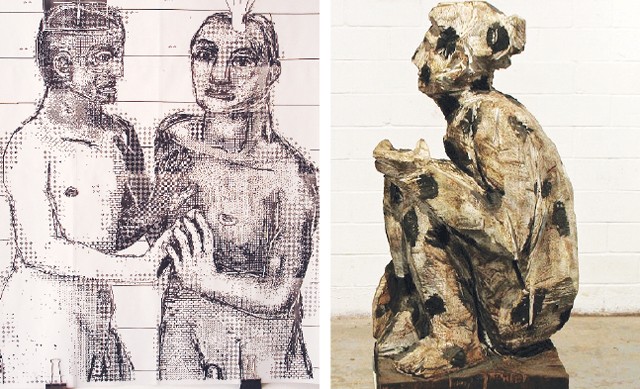Larry Graeber, "Two Worlds: A Look Back"
Free, by appointment
Hausmann Millworks, 925 W Russell
(210) 884-6390, hausmannmillworks.com
Exhibit on view to May 31
Mounted in a long cinderblock room that was once part of an architectural cabinetry shop, the Larry Graeber retrospective “Two Worlds: A Look Back” at Hausmann Millworks has a settled calm about it: more like the lived-in feeling that resonates from small museum collections than the bustle surrounding art galleries. Covering 30 years of painting and sculpture by the SA artist, the show follows Graeber’s focus on figurative works from 1980 through the mid-1990s, to his concerns with geometric abstraction that fill the last 15 years.
That he would develop two forms of expression seems almost predestined. Doubles frequent the room in his early paintings. Immediately to the left of the entrance is a wood table with two sets of paired chairs. Above is another duet — a large drawing of two figures. One is touched, but refuses the other’s glance. On the adjoining wall a painting depicts two male runners in mid-stride. Nearby, the figure of a head displays a tiny couple wrestling as if inside, like thoughts. All from the late 1980s, the paintings are cast in flat, dry pigments with gritty, scraped surfaces. The colors are heavy and dry, and there is a fierce materiality to the surfaces, which seem more like milk paint than the oil they are painted in.
Two sculptures from Graeber’s first decades are also figurative, a standing figure and crouching, but not abject, woman. There is a sort of namelessness here, but not anonymity. References, or perhaps influences, seem to span ages, but most often cull the modern century, collecting late-19th- to mid-20th-century styles. Bits of Matisse, here, Picasso line drawings, there. Spread about the room, the art history references become memories of human history, Graeber’s work reading almost like a collection of artifacts. Underneath the array of shapes, or trials, lies a signature strangely non-assertive, seemingly egoless — but watching.
The geometric works follow grids and stripes that are never measured, straggling crazily across the canvas, almost as curved as rectilinear. In a wall niche is set a small painting of a colored grid. It is placed on the inset back wall, precisely located so that a shadow cast from the ledge above intersects with the top edge of the painting. Similar play with shadows is found throughout the room, the exhibition as much installation as it is collection.
Three small sculptures arrayed on a table represent Graeber’s current sculptural explorations. Box forms, stacked and covered with black electrical and silver reflective tape, are reminiscent of manipulated found object works currently in vogue among many art camps. One, a glued composite of broken pieces of what appears to be plywood, is covered with tar-like flat black. Key to the exhibition, its rough textures form an almost organic shape that echoes the nearby crouching female form. Though similar in shape to the carved wood piece from 1989, it balks at quite assuming life. Vibrant, simmering from all angles, it is made of the detritus of labor.















